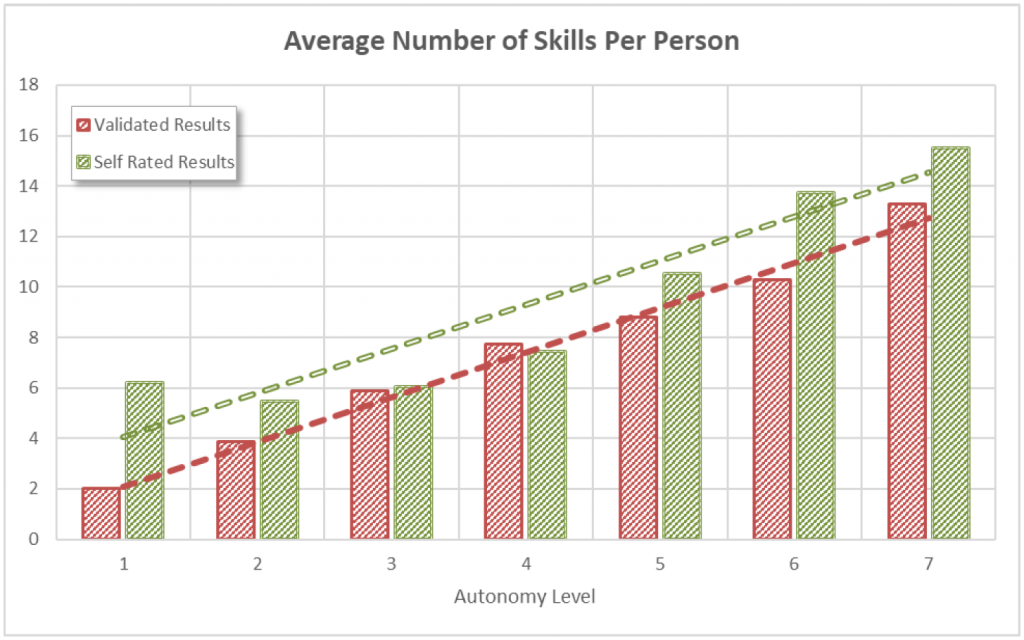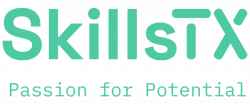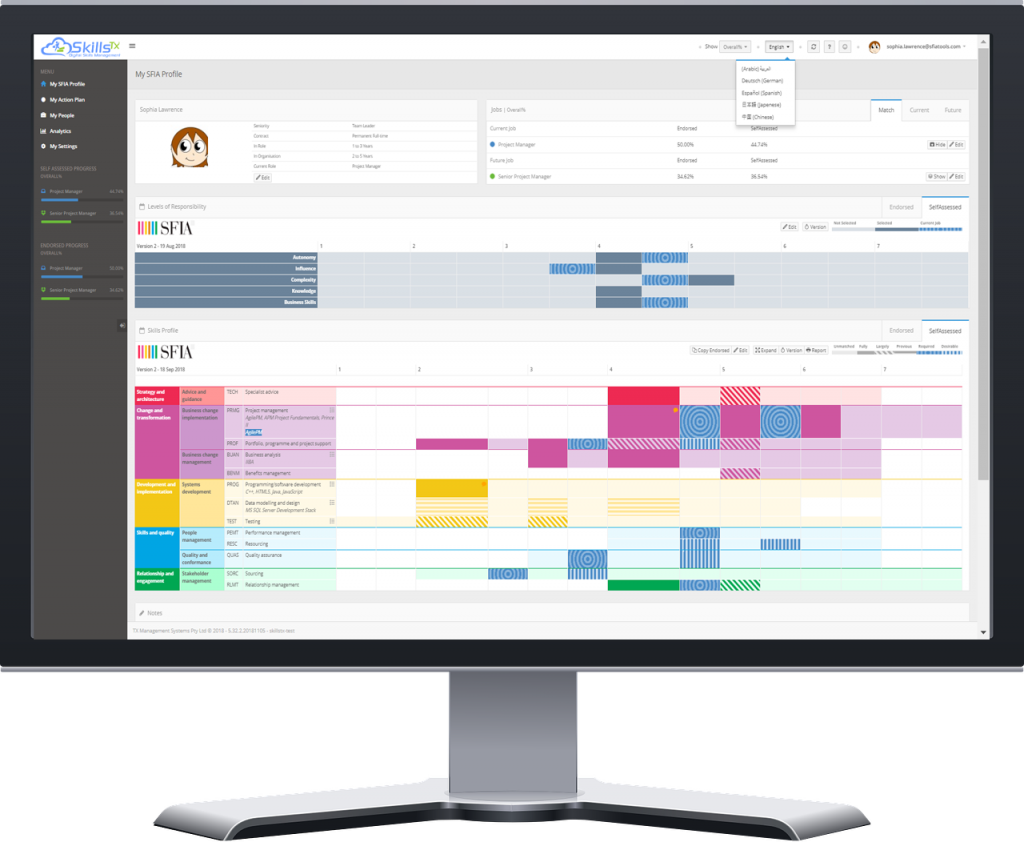People have a lot more skills than required by their current role and more than a third of roles will require a different mix of skills within the next year. So, why restrict skills assessments to the requirements of current roles only.
Consider these statistics:
SFIA (the Skills Framework for the Information Age) Data from the Digital Skills Landscape Report 2018, show that, on average an individual will assess as having 76% more skills than the average number of required skills in a job description.
We find it frustrating that some SFIA consultants, training providers, tool providers, as well as clients, continue to insist on, and support, outdated assessment techniques. The outcomes result in incomplete and inaccurate assessment of their digital, ICT, cyber security, and other related skills defined by SFIA.
Why is it that many continue to get it wrong, thereby undermining the benefits from the outset of their journey? What should they be doing differently?
The purpose of a SFIA assessment
The whole point of assessing your workforce is to build an accurate and complete inventory of all the skills you currently have, producing accurate data that supports good decision making. Being able to answer the “what skills do we have?” question well, is critical to having data-driven answers to important questions, such as:
- Do we already have someone in the company who should be offered this new role? This could be either because they already have the required skills, or they are close enough for it to be a great development opportunity for them.
- Have I already got someone with the skills I need for these critical tasks on a 2-week sprint starting next week? Because if not, I may need to recruit or go to the contract/supplier market.
- What precise actions should be in the skill development action plans?
Earlier in 2018, Gartner said the following:
“Gartner predicts that, by 2020, 75 percent of organizations will experience visible business disruptions due to I&O [IT Infrastructure & Operations Management] skills gaps, which is an increase from less than 20 percent in 2016.
Given the lack of digital dexterity for hire, I&O leaders must begin by developing these skills with the talent they already have.
Most companies don’t have an accurate inventory of the available skills of their current IT workforces, so this must be a first step.”
I’ve underlined “accurate inventory”, as unfortunately there is some bad advice out there which will lead to an inaccurate and incomplete picture of the skills you have.
A common misconception regarding the use of SFIA
Comments like this are unfortunately all too common across the industry:
“Let’s assess the skills they deploy in their current role”
Gartner didn’t recommend that companies should compile an incomplete and inaccurate inventory of their skills by limiting the data they collect to the subset of skills that an individual might be using in their current role.
What about the role a person was doing 6 months ago, or as part of a temporary project assignment last month? Surely these skills are still up-to-date and valid and could be deployed for the benefit of the organisation while also ensuring an individual maintains their current skillset. If you follow poor advice from trainers/consultants, who should know better, you won’t capture this critical data.
More skills than their current role
A McKinsey Global Institute Skill shift report highlighted results from a survey of LinkedIn users that showed “37 percent of respondents said their current jobs did not fully use their skills”. The same publication reported that “the OECD finds that the percentage of the workforce reporting a skill mismatch does not fall below 30 percent in any of the 34 countries it analysed”.
The World Economic Forum, in “The future of jobs” report, stated that:
“On average, by 2020, more than a third of the desired core skill sets of most occupations will be comprised of skills that are not yet considered crucial to the job today”
So, if you only ask about the skills required by their current job today, you’re doing nothing to ensure the individual will still be able to do the job in 2020. That’s only just over 1 year away!
Are we agile enough?
Many companies have a more agile approach to certain tasks these days, compiling teams for sprints or projects. Unless you capture the full set of skills that your individuals have, you will have little chance of knowing whether you may already have people with the right skills and the required levels of experience and responsibility. It is no wonder the IT industry has a reputation for project failure. We are not providing our people with the accurate information that will help them pick the best resources based on having the skills and experience to do the job we need them to do!
Current and future skill needs
One of our government customers in New Zealand, the Inland Revenue, told us:
“A key challenge for the team was the need to understand the skills required to support not only the existing Heritage systems but also those skills required to support the transformation process as well as the new services platform. It was decided that SFIA (Skills Framework for the Information Age) was the framework they would need to ensure they had a consistent and structured set of skills to work from.” https://bsmimpact.com/wp-content/uploads/2017/07/Case-Study-IRD.pdf
They needed to know the skills they needed for their future requirements, not just the roles/jobs they had now. Quite frankly, we would have seriously let them down if we’d followed the outdated advice and approaches I referred to earlier.
A UK local government organisation, CenSus, said:
“The intention and plan at CenSus was to form a single team capable of providing ICT support services for the participating organisations, both for Business As Usual (BAU) activities and for transformational and developmental projects. To do this, it was necessary to understand the skills and capability of each team member to ensure that the right people were in the right roles.
The results for CenSus found that there was a significant amount of potentially untapped capability in resources not currently using previously held skills. Often this represented experience which could be used to mentor others, or to support those working to close their own skill gaps. The resulting report identified that some SFIA skills were not fully present, facilitating an informed discussion about which skill gaps might need to be addressed based on whether they are required by the organisation.”
https://bsmimpact.com/wp-content/uploads/2015/06/Case-Study-CenSus.pdf
Once again, if we had used the wrong method of assessment, we would have totally missed this untapped existing capability.
“I wanted all my staff to understand what their skills were and how we could help them to develop those skills to meet our future needs.”
Steven Woodhouse, Chief Information Officer, NSW Government – Land & Property Information.
To this end, he had to set up a vision of what the organisation would look like. In order to see this ‘future state’, they needed to understand their current situation. LPI turned to SFIA, using the SkillsTX SaaS solution to understand what skills they had currently, and to determine what skills they would need in the future. https://bsmimpact.com/wp-content/uploads/2016/03/Case-Study-NSW-LPI-1.0.pdf
How many skills?
The number of skills per person also provides another interesting requirement that needs to be supported by the assessment tool you choose to use. The results of the self-assessments, and then external independent expert assessments, revealed the following
- Self-Assessment – Average of 13.2 skills per person
- Validation – Average of 8.2 skills per person
The Digital Skills Landscape 2018 report shows a similar view across organisations internationally – so why do I still hear some senior leaders in organisations planning to only capture one or two core skills from each individual?

Ready for Digital Transformation?
Deloitte survey 2018 “Only 16% of executives believe their teams have the capabilities to deliver their digital strategy”. Less than half (45 per cent) of executives are confident in their own digital skills and ability to lead their organisation in the digital economy, while just 16 per cent believe their talent pool has enough knowledge and expertise to deliver their digital strategy.
Four best practice tips for getting an accurate SFIA assessment
- Ensure that you assess the whole individual – all the skills that they have, not just the ones they are using in their current role. This will ensure a complete picture of the skills that you have now. Reject approaches and tools that encourage you to only pick a single core skill or limit it to only 2 skills. Keep in mind that the average number of core skills is 7 or higher.
- Capture all the levels of the skills. People often practice skills at multiple levels. Ensure your assessment tool does not restrict selection to a single level for each skill.
- Use a best practice assessment approach to skill measurement. Recognise that skill selection isn’t always binary. i.e. not as simple as “you either have the skill or you don’t”. Ensure that your assessment tool uses this best practice approach and supports skill development planning, by making use of a graduated assessment approach such as:
o FULLY matched = 85% or higher match between the SFIA description and the activities that the individual has carried out and fully developed in a working environment.
- “Do I recognise the description (>85%) as a current and practiced skill AND do I apply the skill, or could I apply the skill on demand without losing sleep”
o LARGELY matched = between 50% and 85% match, leaving room for development actions to cover any missing areas and/or to ensure consistent and competent performance of the skill is demonstrated.
- “Do I recognise the description (50-85%) as a current and practiced skill BUT I prefer more practice and/or still have things to learn before mastering the skill.”
o PREVIOUSLY = current skills are not a good match to this description; however, it is a good match for skills from earlier in their career.
- “Do I recognise the skill from earlier in my career (85%+ match) AND could I apply it again with some revision or practice AND I would want to.”
o NOT MATCHED = skills are not a good match (between 0 and 50%) for the SFIA description.
- Ensure you assess the Levels of Responsibility (LoR) characteristics (Autonomy, Influence, Complexity, Knowledge and Business Skills) as well as the professional skills. Beware, some assessment tools either totally omit LoR assessment, or restrict selection to the same single level for all characteristics. Our data shows that only 6.8% of people have the same generic LoR level for all 5 characteristics, so you definitely want to avoid 93.2% of your workforce having inaccurate skill profiles that don’t reflect their development needs!
There are many other tips, of course, but at least the above will act as a simple checklist when selecting a tool to support a skills assessment or ensuring you are getting the best advice from your trainers and consultants.
If, as Gartner report, you’re one of the majority of companies who don’t know the skills in your current workforce, make sure your first step is to complete a baseline assessment to answer the “what skills do we have?” question. But make sure you capture all the skills of the individual, not just the ones from their current role, as our data shows that you are likely to have a large untapped skill pool already. You can analyse this data to help make decisions about which skills need to be developed or recruited as a priority.
Experience our SFIA assessment and SkillsTX Planner for free here – Free SFIA self-assessment
To see how SkillsTX makes use of these best practice approaches for your organisation, you can organise a Demo of the full SkillsTX solution here.






